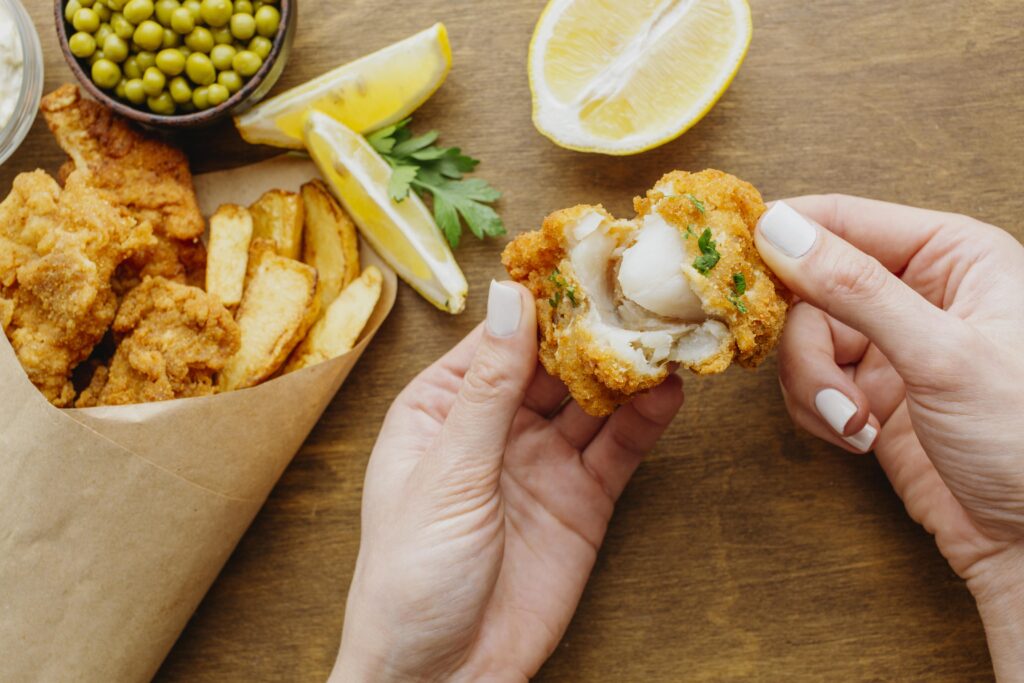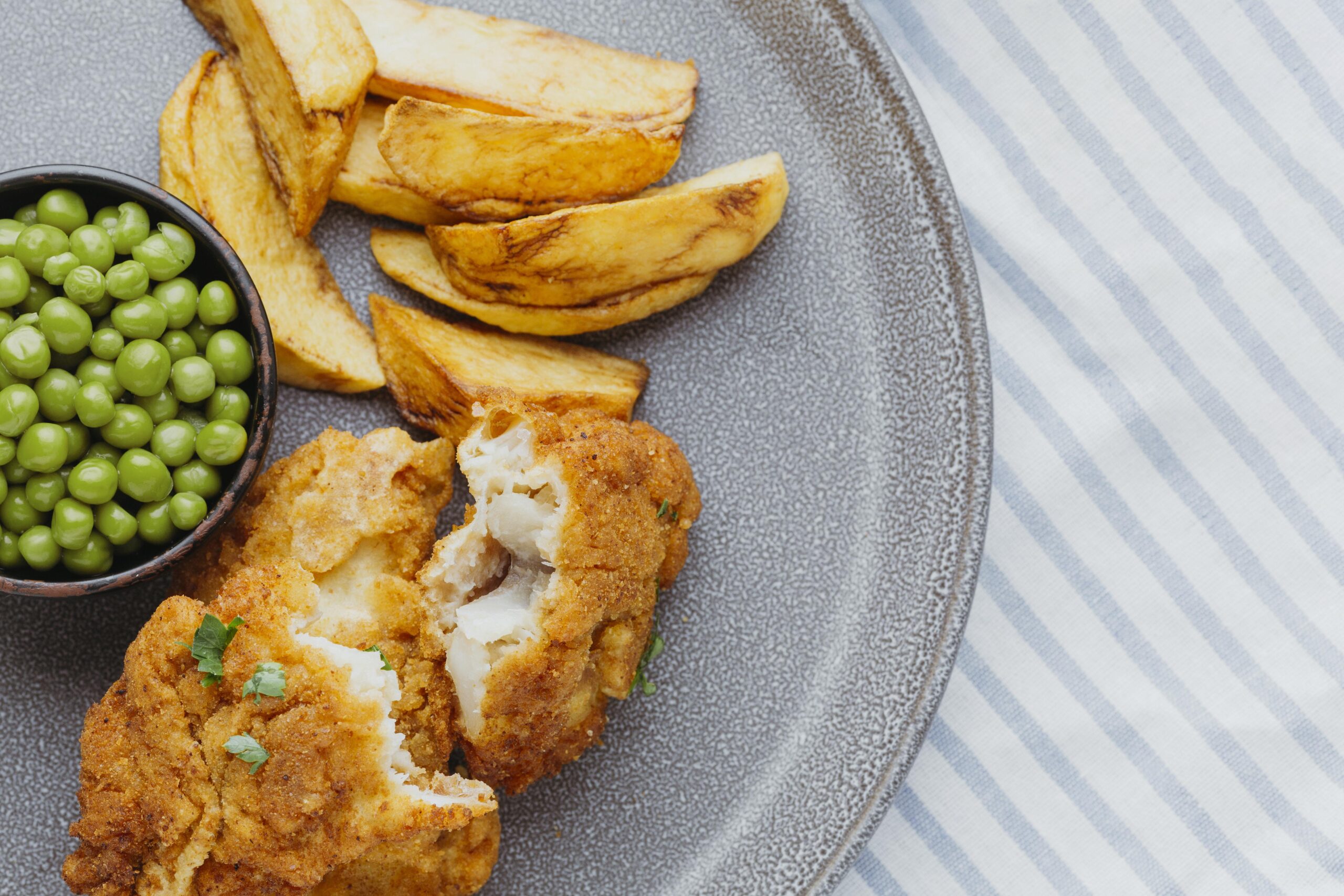Table of Contents

Introduction: Savoring the Delights of Gluten-Free Fish and Chips
Who doesn’t love the classic British dish of fish and chips? The crispy golden batter, tender flaky fish, and perfectly seasoned chips are a mouthwatering combination that has won the hearts of food lovers worldwide. But what if you have celiac disease or gluten sensitivity and thought you could never indulge in this beloved treat? Fear not! In this guide, we’ll explore the wonderful world of gluten-free fish and chips, where the gluten-sensitive can join in on the tasty fun without worry. Let’s dive in and discover the secrets to creating delicious, celiac-friendly delights!
Gluten’s Relationship to Celiac Disease: The Need for Gluten-Free Options
Wheat, barley, and rye all include the protein gluten, which gives dough its elasticity and aids in the preservation of food structure.
However, those who are celiac disease or gluten sensitive may suffer negative health impacts from ingesting gluten.
As an autoimmune ailment called celiac disease, gluten consumption sets off an immunological reaction that wears down the lining of the small intestine.
Instead of generating the same intestinal damage as celiac disease, gluten sensitivity causes gastrointestinal problems and other symptoms.
What Makes Fish and Chips Gluten-Free?
At first glance, traditional fish and chips might seem off-limits for those with gluten issues, considering the dish’s wheat-based batter and fried preparation. But as the popularity of gluten-free cuisine has grown, several eateries and home cooks have developed inventive substitutions to make this popular meal risk-free for consumption by everybody.
The Gluten-Free Batter: Exploring Substitutes
Gluten-free fish and chips are made without using flours derived from wheat. To make a light and crispy batter, use a variety of different flours. Rice flour, chickpea flour, cornstarch, and a blend of gluten-free flours are some further common substitutions. These options provide a similar texture and taste while ensuring the dish remains gluten-free.
Gluten-Free Chips: The Perfect Accompaniment

While potatoes themselves are naturally gluten-free, cross-contamination can occur during the frying process if shared oil is used for gluten-containing items. To ensure truly gluten-free chips, many establishments opt for a separate fryer or dedicate one exclusively to gluten-free items. This precaution ensures that the chips remain safe for those with gluten sensitivities.
Ensuring Celiac-Friendly Preparation: A Key Consideration
When dining out, it’s crucial to pick a place that recognizes the value of preventing cross-contamination.
To avoid any contact with foods containing gluten, gluten-free fish and chips should be made in a different part of the kitchen with separate tools and equipment.
Discovering Delicious Gluten-Free Fish Varieties
The “fish” in gluten-free fish and chips can be made from a range of delectable sources.
Cod and haddock are common white fish that are inherently gluten-free.
However, other seafood alternatives like salmon, tilapia, or even shrimp can be equally delightful when paired with the right gluten-free batter.
Related post:-Crispy and Flavorful Gordon Ramsay Fish and Chips Recipe 4 Easy Steps:
Making Gluten-Free Fish and Chips at Home: A Flavorful Adventure
The method is both satisfying and delicious for individuals who wish to experiment with making gluten-free fish and chips in their own kitchens.
Gluten-Free Fish and Chips Recipe:
Ingredients:
4 fillets of gluten-free white fish (cod, haddock, or any preferred choice)
1 cup gluten-free flour, ideally a rice flour and cornstarch mixture
1 teaspoon baking powder
1 teaspoon salt
1 cup of gluten-free beer or sparkling water (for a light and bubbly batter)
Vegetable oil (for frying)
Potatoes (for chips)
Salt and pepper (for seasoning)
Instructions:
Prepare the chips by slicing the potatoes into thin strips. Spend around 30 minutes soaking them in cold water to help get rid of additional starch, and then pat them dry.
A large saucepan should have vegetable oil that is at least 350°F (175°C) hotter.
While the oil is heating, prepare the batter. In a mixing dish, add the salt, baking powder, and gluten-free flour. Gradually add the gluten-free beer or sparkling water, whisking until you achieve a smooth and thick consistency.
Dip the fish fillets into the batter, coating them evenly.
Carefully place the battered fish into the hot oil and fry until the batter turns golden brown and crispy.
To allow any extra oil to be absorbed, the fish should be removed out of the pan and placed on a dish wrapped with paper towels.
In a separate batch, fry the prepared potato chips until they turn golden and crispy.
To taste, add salt and pepper to the fish and chips.
With your preferred gluten-free dipping sauces, such as tartar sauce or gluten-free malt vinegar, serve hot.
Finally, for individuals who wish to enjoy this well-known dish but have celiac disease or gluten sensitivity, gluten-free fish and chips offer a delicious answer. With the right alternative flours, safe preparation methods, and a dash of culinary creativity, you can savor the crispy goodness without any gluten-related worries. A smile to your face and a full tummy are guaranteed when you eat gluten-free fish and chips, whether you order it out or attempt to make it yourself at home. go ahead and treat yourself to this celiac-friendly culinary experience – you deserve it!

